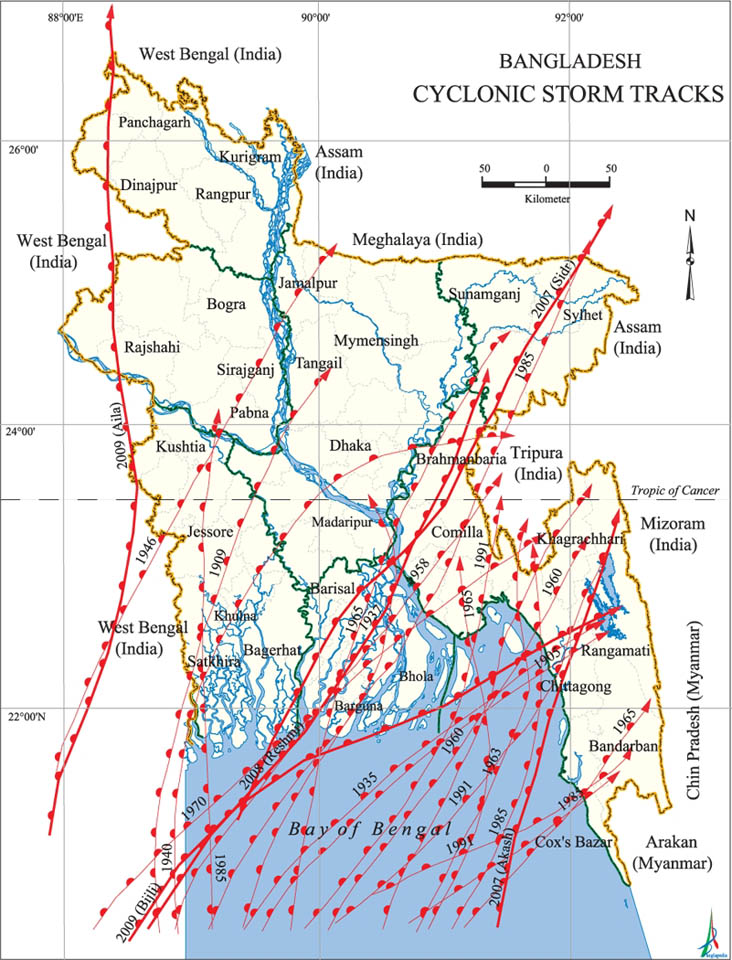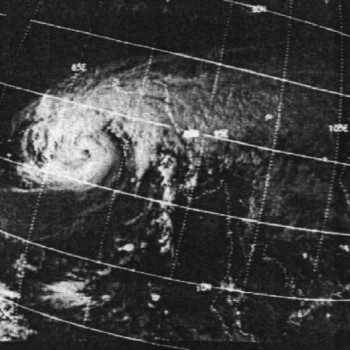A tropical cyclone is regarded as the most destructive meteorological phenomenon. It ravages life and property, especially over the coastal belt, through storm surges and extremely strong winds at the time of landfall (Debsarma et al, 2014). Bangladesh is a cyclone-prone country. Cyclones hit the coastal areas of Bangladesh every year, and on average a severe cyclone, with wind speed ranging 90–119 km per hour, strikes Bangladesh every three years. Cyclone risk spans the entire coastline of Bangladesh, and the historical evidence highlights the danger associated with cyclone-induced storm surges. The vulnerability of Bangladesh may increase even more as current scientific evidence points towards a probable increase in the frequency of intense tropical cyclones in the Bay of Bengal (Dasgupta et al., 2014).
Bangladesh is especially vulnerable to cyclones because of its location at the triangular shaped head of the Bay of Bengal, the sea-level geography of its coastal area, its high population density and the lack of coastal protection systems. During the pre-monsoon (April–May) or post-monsoon (October–November) seasons, cyclones frequently hit the coastal regions of Bangladesh. About 40% of the total global storm surges are recorded in Bangladesh. In the past century, two of the world’s deadliest tropical cyclones occurred in Bangladesh in 1970 and in 1991, killed about 300,000 and 140,000 people, respectively (Islam & Peterson, 2009; Haque et al., 2012).
The Bay of Bengal is a favorable breeding ground for cyclones. About 5.5% cyclonic storms (wind speed greater than or equal to 62 km/hr) form in the Bay of Bengal and about 1% of the global total of cyclonic storms hit Bangladesh. Cyclone is a vortex of low pressure system; Bay of Bengal having sea surface area with 27°C temperature, shallow water in the north Bay, the northward-converging nature of the Bay and high astronomical tides are some of the factors that made the country more prone to tropical cyclone events (CCC, 2009).
Recent findings based on a combination of theory and modeling shows that, as the climate warms, the actual total number of storms should decline globally, but the incidence of the severe Category 3, 4 and 5 storms is expected rise. Also, warming the atmosphere will increase the rainfall from hurricanes, and that should be a major concern.

Fig: Tracks of major cyclones crossed Bangladeshi coast
(Source: https://en.banglapedia.org/index.php/Cyclone)

The eye of Bhola cyclone, 1970 (www. ranker.com)
The deadliest cyclone ever recorded is the 1970 Bhola cyclone that hit Bangladesh (then East Pakistan) and India’s West Bengal on November 12, 1970. While the exact death toll is unknown it is estimated that 300,000-500,000 people perished in the aftermath of this storm, making it the deadliest natural disaster in human history. The cyclone was CAT 3 hurricane. The killing power of the cyclone’s surge flooded most of the low lying islands in the Ganges delta, literally wiping villages and crops off the face of the earth.
The loss of human life didn’t stop immediately and it’s believed that the number may have as much as doubled in the months following the cyclone due to disease and starvation. Officials were criticized by the Pakistani government and media around the world for their poor aid efforts. (www.whatonearth.com)
Table: Historic cyclones and impact in Bangladesh
Year and Name | Affected | Type of | Deaths | Other Information |
1950 (15-20 | Patuakhali | Cyclonic Storm | Unknown | Unknown |
1958 (16-19 | Eastern Meghna | Cyclonic | 870 | Casualty: 14,500 |
1958 (21-24 | Noakhali | Cyclonic | 12,000 people | Approx. 100,000 |
1960 (25-29 | Sundarban Coast (landfall at Sundarban) | Cyclonic | 106 people | Unknown |
1960 (9-10 | Meghna | Severe | 3,000 people. | Maximum Wind:201 km/hour |
1960 (30-31 | Chattogram coast | Severe | 10,000 | Maximum Wind:210 km/h |
1961 (6-9 | Meghna | Severe | 11,468 | Maximum Wind:161 km/h |
1961 (27-30 | Chattogram | Cyclonic | 10,466 | w=95 to 145 km/h and total |
1962 (26-30 | Feni Chattogram coast | Severe | 50,000 | Maximum Wind:161 km/h |
1963 (28-29 | Noakhali | Severe | 11,520 | Maximum |
1965 (11-12 | Barisal | Cyclonic | 19,279 | Wind speed was |
1965 (31 | Chattogram Coast | Severe | 12,000 | Tide plus surge was |
1965 (14-15 | Cox's Bazar Teknaf coast | Cyclonic | 873 | Wind speed was about 217 km per hour and 2.3-3.6 |
1966 (1 | Chattogram and | Cyclonic | 850 | Wind speed was about 139 km per hour associated |
1967 (23-24 | Chattogram-Cox's Bazar | Cyclonic | 128 | w=130 |
1969 (11 | Khulna coast | Cyclonic | 175 | Unknown |
1970 (5-7 | Chattogram-Teknaf | Cyclonic | 18 | w=148 |
1970 (7-13 | Khulna | Severe | 300,000 | Damages include destruction of approximately 20,000 fishing boats, and also property and crops. Total loss of cattle reached more than one million. More than 400,000 houses and 3,500 educational institutions were destroyed. |
1971 (28-30 | Sunderba | Cyclonic | 11,000 | Wind Speed:97– 113 km/h |
1974 (13-15 | Khulna | Cyclonic | 600 | Maximum |
1974 (24-28 | Cox's Bazar | Cyclonic | 200 | Maximum |
1983 | Chattogram-Feni coast | Cyclonic | 43 | w=122 km/h. |
1983 (9 November) | Chattogram-Teknaf | Severe | Unknown | w=136 km/h, |
1985 (24-25 | Noakhali | Severe | 11,069 | - Hit the country |
1986 (9 | Barguna | Cyclonic | 14 | w=110 km/h. |
1988 (29-30 | Sunderban | Severe | 5,708 | - Wind speed was |
1990 (7-8 | Barguna | Cyclonic | Unknow | 150 fishermen with |
1991 (29 | Patuakhali-Cox's | Catastrophic | 138,000 | It caused a damage |
1997 (19 | Coastal | Cyclonic | 155 | Wind speed was |
2007 (15 | Coastal | Cyclonic | 3,363 | - Hit the country’s |
2008 (8 May) | Coastal | Cyclonic | 3500 | Unknown |
2009 (25 | Offshore | Cyclonic | 150 | - 200,000 houses were damaged in the storm |
2013 (16 | Chattogram | Cyclonic | 17 people | Wind speed was 85 km per hour |
2016 (21 | Chattogram | Cyclonic | 26 | Around 40,000 houses were |
2017 (28 May) | Cox’s | Cyclonic | 7 people | High winds, heavy rain and tidal |
2019 (4 May) | - Coastal | Cyclone with | 12 | Cyclone Fani, the strongest storm to hit the Indian |
2020 (21 | Patuakhali, | Cyclone with | 18 people | - Wind speed was 85 km per hour. |
2021 "Cyclone Yaas" | Bhola, Patuakhali, Sathkira, Bagerhat and Barguna. | Cyclone with | 3 people | The cyclonic event affected approximately 1.3 million people, damaged around 26,000 houses as well as 16,183 latrines and 1,986 water points in 9 coastal districts. It is also estimated that around 39 percent of croplands have been damaged and 3,599 hectares of prawn and fish cultivation area affected. |
2022 “Cyclone SITRANG” | Bhola, Bagerhat, Barguna, Cox’s Bazar, Khulna, Patuakhali | Cyclonic Storm | At least 35 people died | Wind speed was highest 74 kmph 2.3 million people affected including 800,000 refugees 1.1 million Children affected 1 million People in cyclone shelters 10,000 houses and crops of 6,000 hectares had been damaged. Another 1,000 fish enclosures were destroyed |
Source: [1], https://reliefweb.int/disasters?advanced-search=%28C31%29_%28TY4618%29
Storm surges
Storm surges are the main cause of destruction from a cyclone. It is a large column of water that washes ashore when a cyclone made landfall. Cyclonic storm surges are dependent on a variety of factors: storm intensity and velocity, radius and pressure of winds, angle of approach and the shape and characteristics of coast, etc. With more intense cyclones it is likely that there will be large storm surges and being a populous delta, the impact will be enormous. The coastal region of Bangladesh is particularly vulnerable to storm surge flooding because of low-lying heavily inhabited areas and continental shelf with shallow bathymetry, which amplifies the storm surge height, causing disastrous floods along the coast (Deb & Ferreira, 2018; Murty et al., 1986; Dube et al., 1997; Madsen and Jakobsen, 2004).
Reference
This website was produced with the support of the United States Agency for International Development (USAID) under the terms of USAID's Research for Decision Makers (RDM) Activity cooperative agreement no. AID-388-A-17-00006
Views expressed herein do not necessarily reflect the views of the U.S. Government or USAID. icddr,b is also grateful to the Governments of Bangladesh, Canada, Sweden and the UK for providing unrestricted/institutional support
68, Shaheed Tajuddin Ahmed Sarani Mohakhali, Dhaka 1212, Bangladesh
icddr,b is located at the Mohakhali area in Dhaka, just ask your driver for the "Cholera Hospital"
